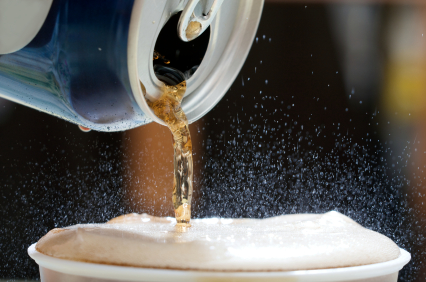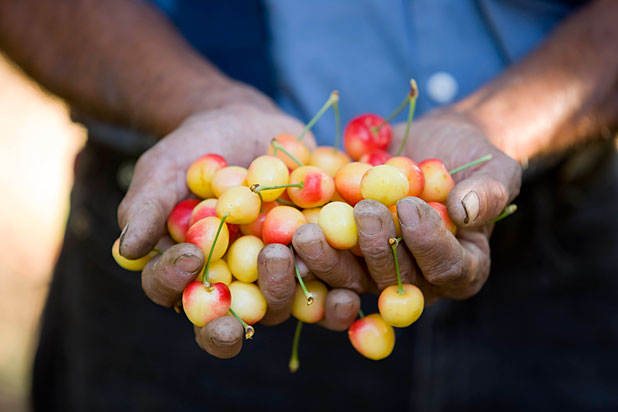 Photos courtesy of Leo Gong/Chronicle Books
Photos courtesy of Leo Gong/Chronicle Books
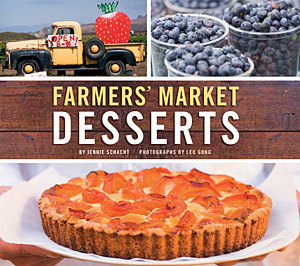
Summer fruits from the farmers market are the supermodels of the produce world. Just like Heidi Klum doesn’t need makeup to be beautiful, a super-fresh White Lady peach or Seascape strawberry doesn’t need extra sweetening or seasoning to shine. But given the right recipe—one designed expressly for fruit and vegetables at their peak ripeness and flavor, not for their wooden supermarket facsimiles—they can really wow your tastebuds.
Just in time for June’s bounty of stone fruits and berries comes Farmers’ Market Desserts. Author Jennie Schacht and photographer Leo Gong visited dozens of farmers markets as well as farms in the San Francisco Bay Area, where Schacht lives; New York City and the Hudson Valley; Wisconsin; Maui; and elsewhere to compile this visually appetizing collection. Grouped according to the season, the recipes hit all the right dessert notes, from familiar ones like sorbets and tarts to more exotic granitas and parfaits. And it’s not all strawberry fields forever—there’s a section for in-between seasons, using dried fruits and nuts and even winter vegetables like squash. Suggestions for substitutions abound, and “Farm Journal” boxes share tidbits from farms Schacht visited, such as Weston’s Antique Apple Orchard, where a Wisconsin family grows some of the last remaining examples of certain apple varieties.
Grist quizzed Schacht by phone this week about how she got into food writing, why she prefers shopping at farmers markets to Safeway, and why the buzzword “organic” rates hardly a mention in her book. And in case you feel inspired to bake over this holiday weekend, she’s also shared her recipes for Strawberries & Cream Cake Roll and Chilled Plum Soup with Sour Cream after the jump.
How do you pronounce your name?
“Shacked,” like shacked up. Or “Shaq attack,” with a “t” at the end and without the “attack” part.
In addition to writing about food, you also consult for food and hunger nonprofits and government agencies. Which came first? Cookbooks or grant proposals?
My background is actually in social welfare—I am a licensed clinical social worker, though currently on inactive status. I worked in community-based health care, for example running a prenatal care program at a Native American health center. In January 1991, I started Schacht & Associates, which helps nonprofit and public organizations to develop health care programs and get them funded.
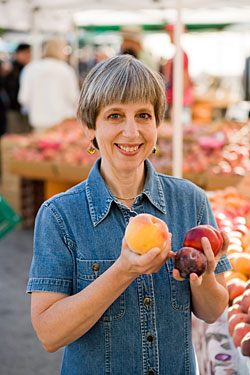 Author Jennie SchachtAt some point I realized I had raised around $20 million in grants, and that obviously my third-grade teacher was wrong—I could write! I grew up being told I was a terrible writer. Even my parents, who were extraordinarily supportive, said it wasn’t my strong suit.
Author Jennie SchachtAt some point I realized I had raised around $20 million in grants, and that obviously my third-grade teacher was wrong—I could write! I grew up being told I was a terrible writer. Even my parents, who were extraordinarily supportive, said it wasn’t my strong suit.
When I realized I was able to persuade funders to give these groups large amounts of money, I decided to try and do some food writing, which I had always wanted to do. I’ve always loved to cook. At a young age I’d tackle stuff from Mastering the Art of French Cooking or from the Julia Child TV show. Looking back now, I had a predisposition toward math and science. One of the things I love about baking and pastry are the marriage of art and science. It’s creative and artistic, so many scientific principles involved.
So I went to Cornell for a summer and got a certificate in food and beverage management, because I thought it was good to have some academia behind me. I wrote a few food articles, and then one day I went to a chocolate tasting with chef Mary Cech, who developed the pastry program at Greystone [the Culinary Institute of America]. I handed her my business card and said, “If you ever want to do a book, call me.” And she did! And that book was The Wine Lover’s Dessert Cookbook.
Farmers’ Market Desserts is your first solo cookbook, right? Was that hard?
Yes, it’s the first I’ve done entirely myself. It’s very touching that Chronicle Books had faith in me, since I don’t have a culinary background, no restaurant or catering company as a portfolio of work. I just went to farmers markets and bought stuff and brought it home and thought, “OK, what would be fun to make with this?”
I’ve always wondered how people create recipes. Do you start with someone else’s and then modify it, or make it up “from scratch”?
I have files and files and notebooks of things I’ve cooked, notes on what I’ve done so I can make it again if I like it, or a variation to try next time. The recipes I’ve developed are things that have worked with my own kitchen experiments over the years. Also, I have a very strong mental taste capacity—a flavor imagination. Sometimes I can actually write a recipe on my computer, print it out, and take it into the kitchen and more often than not it works exactly as I imagined it.
Most Americans seem to view cooking as a chore, something to be outsourced. With cookbooks on their way to becoming anachronisms, how can we entice people to make their own ice cream?
Well, I know even people who cook are intimidated by desserts. I had someone tell me that making granita sounded too complicated because you had to open the freezer and scratch it with a fork every 30 minutes or so. And granita is one of the easiest desserts to make, I think. So I tried to have plenty of things in this book that are really simple, like avocado pudding, that would work even for people who are easily intimidated.
A lot of people are just busy and overtaxed, and they do rely on packaged foods. But there seems to be a new and increasing interest in home cooking, as evidenced by the growth in farmers markets, the Edible publications, the Slow Food movement, and backyard gardening. So I am hopeful. I’ve noticed that when people make something themselves and have the satisfaction of it coming out edible—or better yet, fantastically delicious, better than something in a restaurant—it’s sort of self-igniting.
Why the “Farmers’ Market” Dessert Cookbook? Why not the “Supermarket” Fruit Dessert Cookbook?
First of all, I just love the farmers market. I love that you can talk to and ask questions of the people who grow the food you’re eating. I love that you can see it, touch it, and taste it before you make it. You can try three different kinds of strawberries, and one week one vendor will have the ones you like best and the next week it might be a different one. I love that it’s shopping and community.
With cooking, your outcome to a large degree is only as good as your inputs. It depends where you live. If you want to make dessert and the farmers market isn’t open, if you have a produce stand with good fresh local produce, use it. But if you buy products that have been flown from somewhere far away, they’ve likely been picked before they are ripe, or selected for their durability in shipping, and they’re just not going to taste as good. If you aren’t lucky enough to have a farmers market or a produce stand, then just try to find a reliable source. Even our neighborhood Trader Joe’s has organic produce, and it’s often local. Ask the produce person in your supermarket if you can taste the fruit. They’ll usually let you.
You don’t talk much at all about the organic label in your book.
I prefer organic. But when I go up to someone’s booth and they say they haven’t gotten their certification because they haven’t been doing it long enough, or it’s too expensive, but they don’t spray or use pesticides, then why shouldn’t I buy it? Why should they be penalized? I’m more interested in a combination of food that’s been grown healthfully, with respect to the environment, that’s good tasting, and local. I am not an organic über-alles person.
OK, so what’s your secret junk-food weakness?
I don’t think I have one! I can honestly say I really don’t like processed food. Even when I was growing up, we ate home-cooked food always. We baked our own bread or got it from the local bakery. We used very few packaged products. I don’t think I have ever eaten a McDonald’s hamburger in my life—I stopped eating meat in college. I eat dark chocolate. And I do like a pretzel. Maybe even the two together.
 Strawberries and Cream Cake Roll
Strawberries and Cream Cake Roll
Strawberries & Cream Cake Roll
From Farmers’ Market Desserts by Jennie Schacht (Chronicle Books, May 2010)
This takeoff on strawberry shortcake is elegant enough for a dinner party and, despite a few construction steps, not at all difficult to make. It can be made several hours or even a day ahead, making it perfect for entertaining.
Makes 8 servings
Filling
2 pints (about 4 cups) strawberries, hulled
3 tablespoons granulated sugar
2 teaspoons orange liqueur, such as Grand Marnier (optional)
1 cup heavy cream
1/3 cup crème fraîche or sour cream
1/2 teaspoon pure vanilla extract
Cake
5 large eggs, separated cold, then left at room temperature for at least 30 minutes
2/3 cup granulated sugar
1 teaspoon pure vanilla extract
1 cup cake flour, sifted before measuring
1/2 teaspoon kosher salt
Confectioners’ sugar, for rolling and finishing
1. To begin the filling, set aside 1 cup of the berries for garnish. Cut the remainder into 1/2-inch-thick slices and toss with 2 tablespoons of the sugar and the liqueur (if using). Set aside at room temperature to get acquainted while you prepare the cake batter.
2. Preheat the oven to 400ºF, with a rack near the center. Oil a 17-by-12-inch rimmed baking sheet and line with a silicone baking mat or parchment paper. Oil the mat or parchment.
3. To make the cake, in the bowl of a standing mixer fitted with the whisk attachment (or with a handheld mixer), beat the egg whites on medium speed until they hold soft peaks. Add 1/3 cup of the granulated sugar in a slow, steady stream, then increase the speed to medium-high and continue to beat until the whites hold medium-firm peaks. Set aside.
4. In a large bowl, using the mixer with the whisk attachment, beat together the egg yolks, vanilla, and the remaining 1/3 cup sugar on high speed until thick and pale, about 5 minutes with a standing mixer and a little longer with a handheld mixer. Stop and scrape down the sides of the bowl as needed. On low speed, mix in the flour and salt just until combined.
5. Whisk the whites briefly to bring them back to medium-firm peaks. Using a large spatula or whisk, gently fold one-third of the whites into the yolk mixture to lighten it, then fold in the remaining whites just until combined.
6. Immediately pour the batter into the prepared pan and spread evenly. Bake until the top feels dry and springs back when you press it lightly with your finger near the center, about 8 minutes. It should remain pale. Transfer the pan to a wire rack, cover with a tea towel, and let cool for 10 minutes.
7. Run a thin knife around the inside edge of the pan to loosen the cake sides. Using a fine-mesh strainer, dust the top of the cake lightly with confectioners’ sugar, re-cover the cake with the towel, and invert a rimless baking sheet on top. Invert the pans together, releasing the cake onto the towel and rimless sheet. Lift off the top pan and peel off the mat or parchment. Let the cake cool completely, 20 to 30 minutes longer.
8. To complete the filling, using a chilled bowl and beaters, whip the cream, crème fraîche, vanilla, and the remaining 1 tablespoon sugar until the mixture holds firm peaks. Strain the berries, capturing their juices in a bowl, and fold the drained berries into the cream.
9. Cut the berries reserved for garnish in half, from top to tip. Mix them with the reserved berry juices.
10. Position the cake with a long side parallel to the edge of the work surface, and place a serving platter at the opposite long side. Spread the cream filling evenly over the cake, leaving a narrow border on the short sides and a 1-inch border along both long sides.
11. Starting at the long side closest to you, fold the 1-inch border tightly over the filling, then begin to roll, using the towel to help form a compact roll and pulling it out of the way as you go. Then, use the towel to help you transfer the cake, seam-side down, onto the serving platter. Use a thin or serrated sharp knife to trim just a bit from the ends of the cake to create a slight angle (baker’s snack!). Refrigerate the cake, tightly covered, until very cold, about 2 hours or up to 1 day.
12. Sift confectioners’ sugar over the top, and spoon the reserved berries around the base. Cut the cake with a thin or serrated sharp knife at a slight angle, using a gentle sawing motion.
Season to Taste: In place of the sliced strawberries, use raspberries, olallieberries, or blackberries, coarsely chopped if very large. In the filling, substitute crème de cassis for the Grand Marnier with blackberries, or raspberry liqueur with raspberries.
Farm Journal: If you are accustomed to shopping in a supermarket, you may not know that many strawberry varieties are cultivated, each with its own constellation of size, color, texture, and flavor. Don’t discriminate against strawberries because of their size, shape, or color. Instead, follow your nose: fragrant berries are likely to be ripe and flavorful.
Chandler, Diamante, Douglas, Ogallala, Seascape, Sequoia, and Sweet Charlie varieties are particularly flavorful, with the Ogallala combining the floral aroma and flavor of wild strawberries with the larger size of domesticated (or farmed) varieties. Which are available at your market will depend on where you shop, but the farmers’ market gives you the perfect chance to taste and discover the sweetest for yourself.
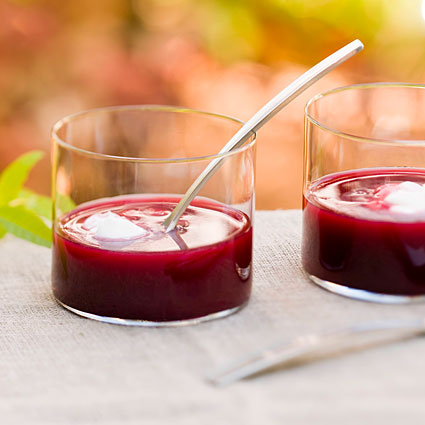 Chilled Plum Soup with Sour CreamChilled Plum Soup with Sour Cream
Chilled Plum Soup with Sour CreamChilled Plum Soup with Sour Cream
From Farmers’ Market Desserts by Jennie Schacht (Chronicle Books, May 2010)
One childhood role I had was to re-create my grandmother’s best hits for my dad. Plum soup with sour cream, which he called by its Yiddish name, pomella, was one of his favorites. This grown-up version is every bit as satisfying, served in shot glasses as a sort of dessert amuse-bouche, or in bowls accompanied by crisp Hazelnut-Almond Biscotti, Lavender-Walnut Sandies, or Market Jam Gems, made with plum jam if you can find it. The soup is perfect for making in advance because it needs time to chill. If you have leftover soup, take a tip from recipe tester Emily Lichtenstein: freeze it in Popsicle molds for a refreshing plum pop!
Use flavorful, dark flesh plum varieties, such as Santa Rosa or Yummy Rosa, for the soup. The fruit should be quite ripe and soft but not bruised. This recipe is a great way to use up plums about to go over the hill.
Makes 6 to 8 servings
4 cups water
2/3 cup granulated sugar
1/4 teaspoon kosher salt
Few twists of black pepper
2 pounds firm-ripe plums, pitted and coarsely chopped
1 sprig lemon verbena, about 4 inches long (optional)
2 tablespoons crème de cassis or other berry liqueur
1/2 teaspoon finely grated lemon zest
2 teaspoons fresh lemon juice
About 1/2 cup sour cream or crème fraîche, for serving
6 to 8 small sprigs mint or lemon verbena, for garnish
1. Combine the water, sugar, salt, and pepper in a large, heavy, nonreactive saucepan over medium-high heat and bring to a boil, stirring until the sugar is completely dissolved. Add the plums, bring back to a boil, and then reduce the heat to a gentle simmer. Skim off any foam that rises to the top, stirring occasionally, until the fruit is very soft and falling apart, about 20 minutes.
2. Remove from the heat and stir in the lemon verbena sprig (if using). Let cool for about 20 minutes, tasting occasionally and removing the lemon verbena when its flavor has perfumed the soup to your liking. It should be a delicate background note, not a predominant flavor.
3. Puree the soup until smooth using an immersion blender, standard blender, or food processor. Stir in the crème de cassis and lemon zest and juice. Cover and refrigerate until very cold, about 4 hours or up to 4 days.
4. Ladle the chilled soup into shallow bowls. Top each serving with a dollop of sour cream and a mint sprig.
Season to Taste: Try other stone fruits, such as peaches, nectarines, or cherries. Strawberries or blackberries also make a delicious soup, though you may want to strain out the seeds. Omit the cassis or substitute a complementary light-colored liqueur for light-colored fruits.
